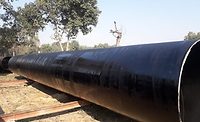Coal Yields Plenty of Graphene Quantum Dots
Rice U. scientists find simple method for producing dots in bulk from coal, coke.

HOUSTON – The prospect of turning coal into fluorescent particles may sound too good to be true, but the possibility exists, thanks to scientists at Rice University.
The Rice lab of chemist James Tour found simple methods to reduce three kinds of coal into graphene quantum dots (GQDs), microscopic discs of atom-thick graphene oxide that could be used in medical imaging as well as sensing, electronic and photovoltaic applications. The findings were reported in the journal Nature Communications.
Band gaps determine how a semiconducting material carries an electric current. In quantum dots, band gaps are responsible for their fluorescence and can be tuned by changing the dots’ size. The process by Tour and company allows a measure of control over their size, generally from two to 20 nanometers, depending on the source of the coal.
There are many ways to make GQDs now, but most are expensive and produce very small quantities, Tour said. Though another Rice lab found a way last year to make GQDs from relatively cheap carbon fiber, coal promises greater quantities of GQDs made even cheaper in one chemical step, he said.
“We wanted to see what’s there in coal that might be interesting, so we put it through a very simple oxidation procedure,” Tour explained. That involved crushing the coal and bathing it in acid solutions to break the bonds that hold the tiny graphene domains together. “You can’t just take a piece of graphene and easily chop it up this small,” he said.
Tour depended on the lab of Rice chemist and co-author Angel Martí to help characterize the product. It turned out different types of coal produced different types of dots. GQDs were derived from bituminous coal, anthracite and coke, a byproduct of oil refining.
The coals were each sonicated in nitric and sulfuric acids and heated for 24 hours. Bituminous coal produced GQDs between two and four nanometers wide. Coke produced GQDs between four and eight nanometers, and anthracite made stacked structures from 18 to 40 nanometers, with small round layers atop larger, thinner layers. (Just to see what would happen, the researchers treated graphite flakes with the same process and got mostly smaller graphite flakes.)
Tour said the dots are water-soluble, and early tests have shown them to be nontoxic. That offers the promise that GQDs may serve as effective antioxidants, he said. Medical imaging could also benefit greatly, as the dots show robust performance as fluorescent agents.
“One of the problems with standard probes in fluorescent spectroscopy is that when you load them into a cell and hit them with high-powered lasers, you see them for a fraction of a second to upwards of a few seconds, and that’s it,” Martí said. “They’re still there, but they have been photo-bleached. They don’t fluoresce anymore.”
Testing in the Martí lab showed GQDs resist bleaching. After hours of excitation, Martí said, the photoluminescent response of the coal-sourced GQDs was barely affected. That could make them suitable for use in living organisms. “Because they’re so stable, they could theoretically make imaging more efficient,” he said.
A small change in the size of a quantum dot – as little as a fraction of a nanometer – changes its fluorescent wavelengths by a measurable factor, and that proved true for the coal-sourced GQDs, Martí said.
Low cost will also be a draw, according to Tour. “Graphite is $2,000 a ton for the best there is, from the U.K.,” he said. “Cheaper graphite is $800 a ton from China. And coal is $10 to $60 a ton.
“Coal is the cheapest material you can get for producing GQDs, and we found we can get a 20 percent yield. So this discovery can really change the quantum dot industry. It’s going to show the world that inside of coal are these very interesting structures that have real value.”
Co-authors of the work include graduate students Ruquan Ye, Changsheng Xiang, Zhiwei Peng, Kewei Huang, Zheng Yan, Nathan Cook, Errol Samuel, Chih-Chau Hwang, Gedeng Ruan, Gabriel Ceriotti and Abdul-Rahman Raji and postdoctoral research associate Jian Lin, all of Rice. Martí is an assistant professor of chemistry and bioengineering. Tour is the T.T. and W.F. Chao Chair in Chemistry as well as a professor of mechanical engineering and materials science and of computer science.
The Air Force Office of Scientific Research and the Office of Naval Research funded the work through their Multidisciplinary University Research Initiatives.
Looking for a reprint of this article?
From high-res PDFs to custom plaques, order your copy today!







